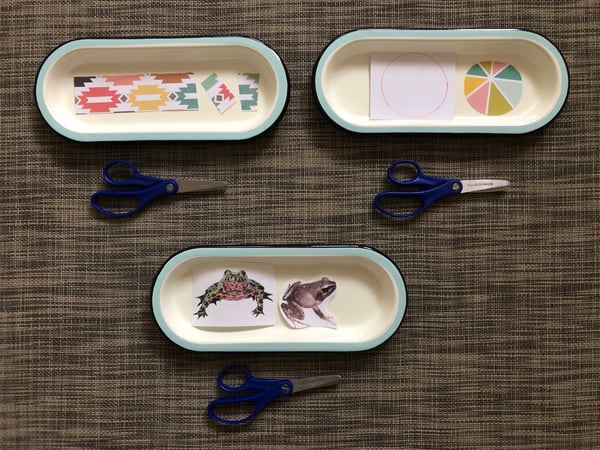With spring, comes spring cleaning and organizing! The Montessori learners have been enjoying refreshing the studio by wiping down shelves and washing materials as we rotate our units of study. We rotate our materials for two reasons:
David Kirby
Recent Posts

“The senses, being explorers of the world, open the way to knowledge.” — Maria Montessori
In our Acton Program for Families event, Acton parents are led through a series of sensory-based exercises using quintessential Montessori materials.
What do you notice about the Pink Tower? The pieces are cubes; they can ascend (or descend) in size; and, yes, the fact that it is entirely pink is an important observation!
The purpose of the sensorial area in the Montessori studio is not to create sensory perception, but to help the child develop and refine sensory perception. The sensorial materials isolate a particular quality; in the case of the Pink Tower, dimension. By isolating a quality, the child can focus his attention on it, explore it, expand on it, create a classification for it, experiment with how it relates to others of its kind, and, eventually, form an abstraction in his mind so that through his imagination, it is always with him.
Takeaways from working with the Montessori sensorial materials:
1 - Abstraction: The ability to create and hold pictures in the mind. Abstractions come from repeated interactions with concrete objects, until eventually the mind no longer needs the physical object but can go directly to the mental image. If I say the word “mug,” you have a picture in your mind of a mug, and you do not need to hold a mug in your hand to understand what I mean.
2 - Classification: The human tendency to look for patterns and make classifications of objects and behaviors. The child who points to a picture in a book and says “kitty” has already made a classification of cats as separate from dogs. Dogs and cats both have four legs, fur, ears, tails, teeth, whiskers, paws and claws, but the child notices what is different between cats and dogs. It is identifying the difference that aids in her classification.
3 - Language: We help the child focus her attention on the precise language that accompanies a specific sensorial experience. The experience is like the hook, and the language is the hat; without the hook, there is nothing on which to hang the hat.
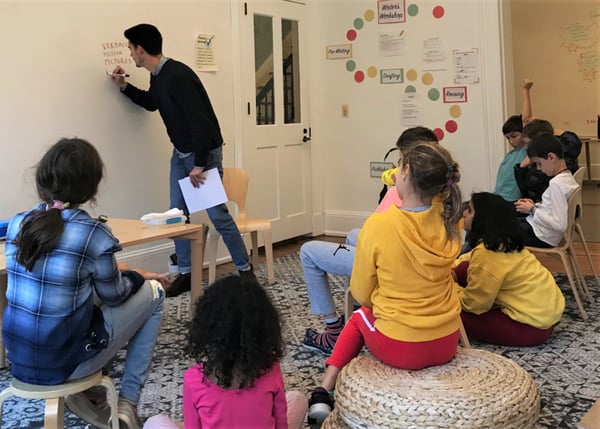
Elementary learners work through each session focused on “the dip.” The dip is a natural part of learning in nearly every activity. When you try something new, at first it can be exciting and you might experience initial success, which makes you feel happy about your progress. But as you continue, at a certain point it may get tough and the results may not come as quickly or as easily as they did at first, despite all the effort you might be putting in. This stage is called the dip.
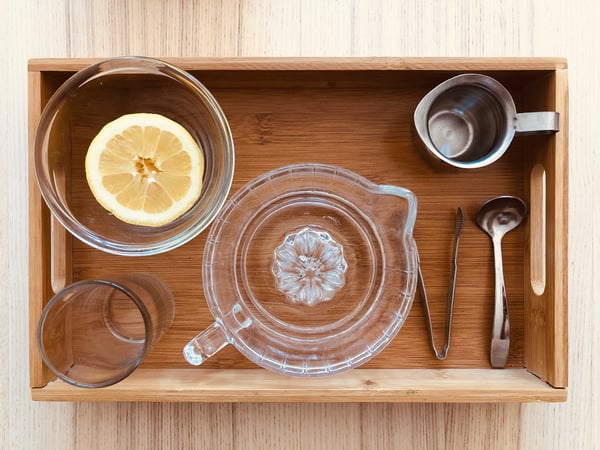
When Life Hands You Lemons...
….Make lemonade! In the Montessori studio, our learners experience many different cooking techniques. One of these is juicing. We have a bowl of halved lemons next to a tray containing a glass juicer, small bowl, pitcher (filled with sugar water), and stirrer. Our sugar water is premade by the guides in the morning and placed in a larger pitcher for each child to replenish independently for the next person.

Elementary learners use a special tool in the studio: the freedoms and responsibilities scale. At Acton, learners are given freedoms and responsibilities that are not typical of many learning environments. These range from doing studio maintenance to setting weekly goals to choosing which core skills area to work on. However, these freedoms and responsibilities aren’t simply granted, they must be earned and respected by learners.
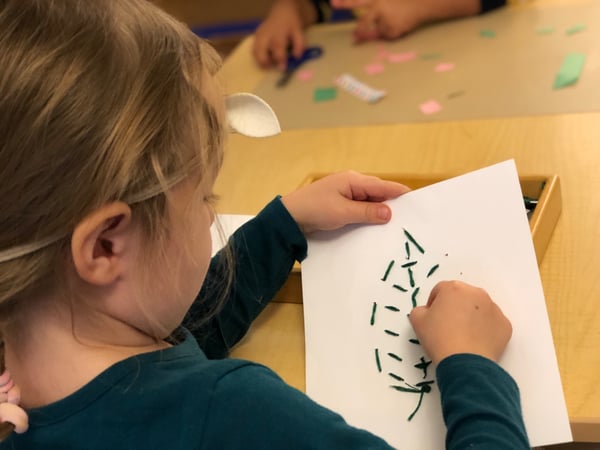
Sewing is becoming a popular activity in our Montessori studio. Knowing how to sew is a useful skill with lifelong practical applications and benefits. It requires concentration, focus, and problem solving, and helps develop hand-eye-coordination and fine motor skills. For these reasons, sewing falls under Practical Life activities in the Montessori curriculum. More specifically, sewing encourages children to care for themselves, meet their own needs, and foster functional independence. The goal is that one day a child notices there is a hole in his favorite socks, and follows up this observation with action—fixing it himself!
At the beginning of the year, we start with a variety of lacing tools, from simple beading to continuous lacing frames. When the child is ready, we introduce a blunt needle and thread and begin sewing on sturdy material, such as cardboard or cardstock, with premade holes. The trick is to follow the pattern and build muscle memory for basic stitching. From there, we introduce soft fabrics such as burlap and felt for a child to begin strengthening her hand by puncturing the holes independently and applying the movements she has been practicing.
This week, there are a variety of sewn mittens hanging on our display board outside the Montessori studio. Sewing also allows for children’s creativity to shine! The learners have fun picking fabric and deciding which color thread to use or which beads or buttons to add.
On cold, wintry days, this is a wonderful activity to replicate at home. Start sewing in your home with this great beginners board or these lacing frames. And check out Sewing in the Montessori Classroom for more information about the science behind sewing and projects for all ages.
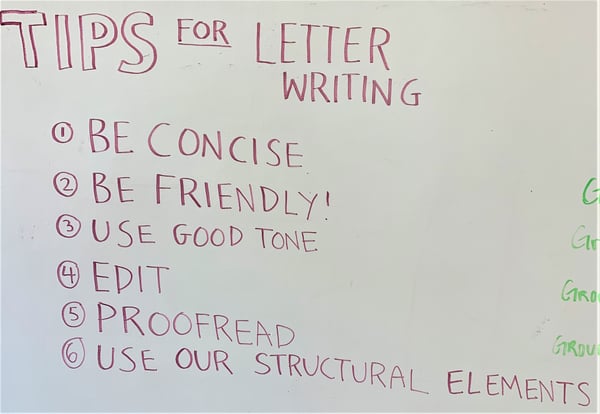
As part of our writer’s workshop, “Letter to a Hero,” the learners dove a little bit deeper into the elements of a letter and the best practices that will help them write polished letters to their heroes. We began with a broad question: what are the most important parts of a letter? The learners were put into two groups and had 20 minutes to research, explore, and create a list of the important parts of a letter for discussion. As a group, they came up with the following:

Poetry is powerful, and in the Montessori studio, that power is recognized. Poems are easy to memorize, and when children are able to recite a poem, it gives them a sense of pride and accomplishment. So far, our Montessori learners know three poems: “Bear in There” by Shel Silverstein, “Winter Animals” (see images above), and our “Thank You Poem,” which we recite aloud before we eat a meal together (see Thanksgiving blog post for poem).

“You get out what you put in.”
It’s a straightforward sentiment, and one that is applicable to nearly any endeavor. This concept was brought up during CrossFit as a way to explain the benefits of pushing yourself. Coach Andrew said:
This is going to be a tough workout today, and you have options. You can give it your all and use proper form on every jumping jack and and sit up, or you can go on autopilot. It’s your choice, but, at the end of the day, will you want to look back and feel like there was something you could’ve worked harder at? Will you want to feel like you’re not allowing yourself to get as good as you can possibly be?
At close that day, the idea of getting out what you put into something was raised again. The guides asked the learners what that meant to them. One learner responded, “It means the benefits at the end are equal to how much effort you put in.” A lot of heads nodded in agreement.
The discussion then shifted to talking about times at Acton that the learners have seen this principle at work. One learner responded that Khan math requires a lot of time to understand the concepts, but that the more time put in, the easier it is to build on the material and make progress faster. Another said that writer’s workshop and the writing process is an example of getting out what you put in: “If you don’t follow all of the steps properly in brainstorming, drafting and editing, your work won’t be as good as it could be.”
At Acton, learners regularly face challenges that require time, effort, and focus. There might be areas of core skills they prefer over others, and there might be particular writing genres they find easier to devote energy to. They might dislike certain games and be excited to play others for hours on end. The key is understanding that they have the capacity to put their full effort into anything they choose.
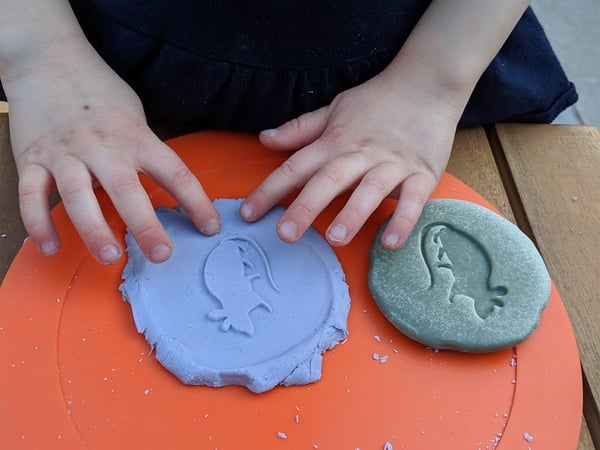
"The hands," wrote Dr. Maria Montessori, "are the instrument of man's intelligence." Squishing, rolling, sculpting, molding . . . young children love to play with playdough. Add some props from around the home and playdough play becomes a powerful way to support your child’s learning. This simple preschool staple lets children use their imaginations and strengthen the small muscles in their fingers—the same muscles they will one day use to hold a pencil and write.
Through manipulations, children develop eye-hand coordination, the ability to match hand movement with eye movement. They also gain strength and improve dexterity in their hands and fingers, critical areas of physical development for writing, drawing, using scissors, zipping zippers and buttoning buttons.
When children use this malleable material, they explore ideas and try different approaches until they find one that works. They compare and contrast objects ("Mine is a fat pancake and yours is skinny”), actions ("Let’s scrape it, like this”), and build connections with patterns, lines, and shapes ("We were making a snake, but now it looks like a really long road”). In their experimenting, children come up with their own ideas, satisfy their curiosity, and analyze problems.
Add sand or water to the playdough and then talk about how this new kind of dough looks and feels. Introduce words like texture, grainy, smooth, and lumpy. Your child might declare, "I’m making this flat!” as she pushes down on playdough with the palm of her hand. Or she may say, "I’m making it soft,” as she adds water to dry playdough to make it more pliable.
Make your own batch of playdough at home and see for yourself!
INGREDIENTS:
